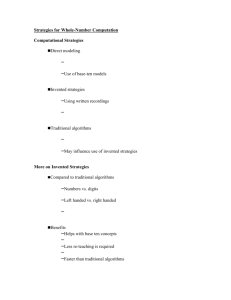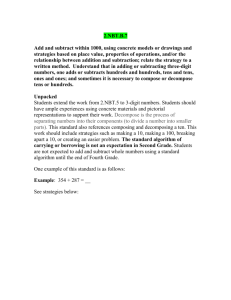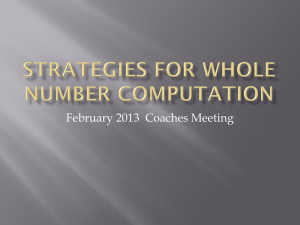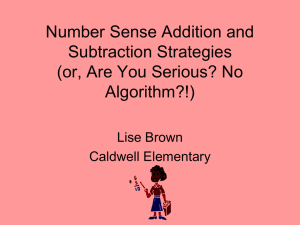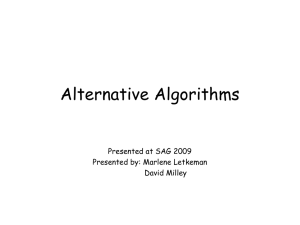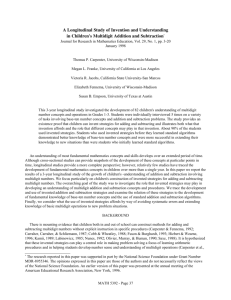3.NBT_.A.2
advertisement
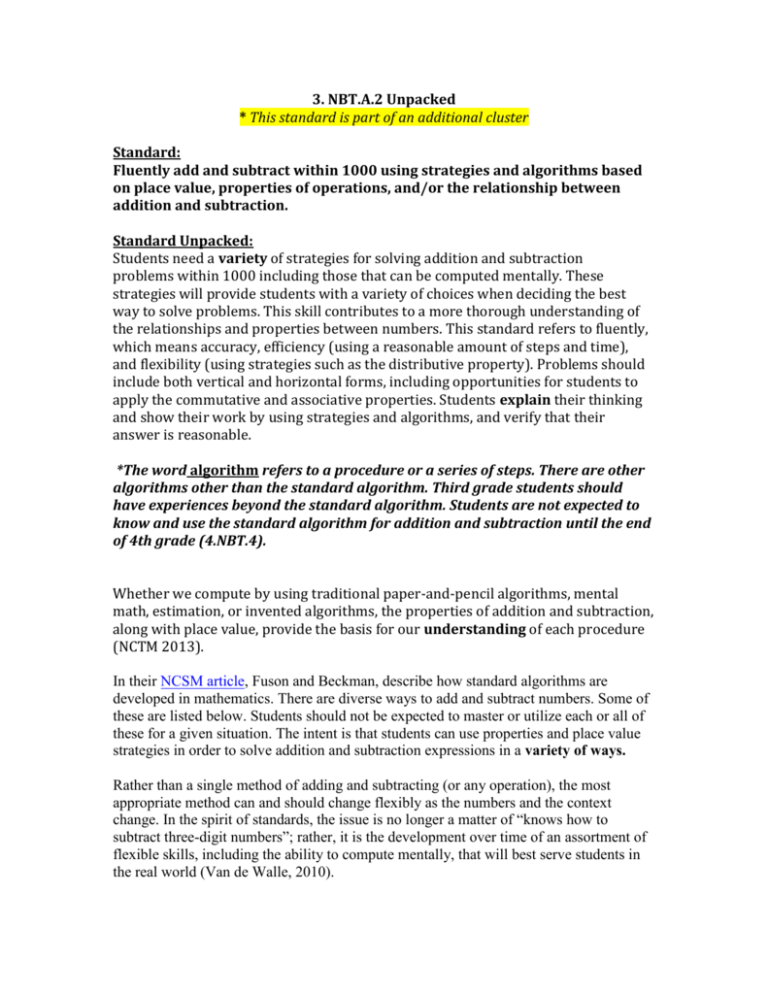
3. NBT.A.2 Unpacked * This standard is part of an additional cluster Standard: Fluently add and subtract within 1000 using strategies and algorithms based on place value, properties of operations, and/or the relationship between addition and subtraction. Standard Unpacked: Students need a variety of strategies for solving addition and subtraction problems within 1000 including those that can be computed mentally. These strategies will provide students with a variety of choices when deciding the best way to solve problems. This skill contributes to a more thorough understanding of the relationships and properties between numbers. This standard refers to fluently, which means accuracy, efficiency (using a reasonable amount of steps and time), and flexibility (using strategies such as the distributive property). Problems should include both vertical and horizontal forms, including opportunities for students to apply the commutative and associative properties. Students explain their thinking and show their work by using strategies and algorithms, and verify that their answer is reasonable. *The word algorithm refers to a procedure or a series of steps. There are other algorithms other than the standard algorithm. Third grade students should have experiences beyond the standard algorithm. Students are not expected to know and use the standard algorithm for addition and subtraction until the end of 4th grade (4.NBT.4). Whether we compute by using traditional paper-and-pencil algorithms, mental math, estimation, or invented algorithms, the properties of addition and subtraction, along with place value, provide the basis for our understanding of each procedure (NCTM 2013). In their NCSM article, Fuson and Beckman, describe how standard algorithms are developed in mathematics. There are diverse ways to add and subtract numbers. Some of these are listed below. Students should not be expected to master or utilize each or all of these for a given situation. The intent is that students can use properties and place value strategies in order to solve addition and subtraction expressions in a variety of ways. Rather than a single method of adding and subtracting (or any operation), the most appropriate method can and should change flexibly as the numbers and the context change. In the spirit of standards, the issue is no longer a matter of “knows how to subtract three-digit numbers”; rather, it is the development over time of an assortment of flexible skills, including the ability to compute mentally, that will best serve students in the real world (Van de Walle, 2010). Before moving into various strategies and algorithms, it is important to make note that you will need to introduce and explain each algorithm to help them understand how and why they work. When students are sharing invented strategies it is imperative they share or summarize their strategies with the class, and you guide the conversation through thoughtful discourse to make sense of student invented strategies. No matter how carefully you introduce these algorithms into your classroom as simply another alternative, students are likely to sense that “this is the real” or “right way” to compute. Once having begun with traditional algorithms, it is extremely difficult to suggest to students that they learn other methods (Van de Walle, 2010). Invented Strategies: * noting the observation above in regard to teaching algorithms, student invented strategies are an important and strategic progression into the direct instruction/introduction of algorithms. Invented strategies are developed out of a strong understanding of numbers. The standard development of place value often leaves students ill prepared for the challenges of inventing computational strategies. For example, some third and fourth-grade students have difficulty naming a number that is ten more or ten less than a given two-digit number. Therefore, students need a classroom environment were they can act like mathematicians and explore ideas without trepidation. Here are some factors to keep in mind: Expect and encourage student to student interactions, discussions, and conjectures Celebrate when students clarify previous knowledge Encourage curiosity and an open mind when trying new things Talk about both right and wrong ways in a non-evaluative or threatening way Move unsophisticated ideas to more sophisticated thinking through coaxing, coaching, and guided questioning Use contexts and story problems to capture student interest Consider carefully whether you should step in or step back when students are formulating new ideas (when in doubt-step back) (Van de Walle, 2010) The Launch Explore Summarize lesson is a good structure for an invented strategies lesson, because students are encouraged to explore and share their thinking with their peers. Invented Addition Strategies Problems involving the sum of 2 or more digits will provoke a wide variety of strategies. One way may be a strategy that involve starting with one or the other number and working from that point, either by adding on to get the next ten or by adding tens, hundreds, thousands etc. from one number to the other. Other approaches involve decomposing or splitting the numbers in parts and adding the easier parts separately. Example: 46 + 35 A student may add four more to 46 to get fifty, and then add 31 to fifty. A student might first add 30 to 46 and then add 4 more to get 80 and 1 more. A student might first decompose the numbers into tens and ones, and then add. 40 + 6 + 30 + 5, and then rearrange the order to 40 + 30 = 70 and 6 + 5 = 11, therefore 70 + 11 = 81 One example of an invented strategy: Invented Subtraction Strategies Subtracting by Counting Up: This strategy is very powerful for many expressions, but not appropriate for all. An example would be for 38-19 the idea is to think, “How much do I add to 19 to get 38?” The following problem and those like it lend themselves to be solved using “counting up.” Simply asking for the difference between two numbers may also prompt this strategy (Van de Walle). Jennifer counted all of her markers. Some of them worked and some did not. She had 68 markers in all. 36 of the markers did work. How many do not work? The following examples illustrate this problem. Add Tens to Get Close, Then Ones 68-36 36+30 (40 is too much) Then add two more is 68. That’s 30 and 2 or 32. Add Ones to Make a Ten, Then Tens and Ones 68-36 36 and 4 is 40. 40 and 20 is 60. 8 more is 68. 4+20=24 24+8=32 Take-Away Subtraction: When the subtracted number is a multiple of ten or close to a multiple of ten or close to a multiple of ten, take-away can be an easy method to use (Van de Walle, 2010). Example: There were 63 students in the cafeteria. The 48 students who finished their lunch went out to recess. How many children are still in the cafeteria? The following examples illustrate this problem: Take Tens from the Tens, then subtract Ones 63-48 60-40 is 20 Then take away 8 more is 12 Now add back 3 ones is 15 Take Away Tens, Then Ones 63-48 63- 40= 23 Then take away 8 more. 23-8=15 Partial Sums: Partial sums uses base 10 concepts. This method does not involve regrouping at all. This method adds each place value separately, and then adds the sums. Example: Opposite Change (or “give and take” or “add-subtract”) In this procedure, the goal is to change one of the numbers to a multiple of 10 (or 100 or 1,000) so that it is easy to add. We can accomplish this by adding a number to one of the addends and subtracting it from the other (NCTM, 2013). Working With a Hundreds chart: By using the hundreds chart to add and subtract, students can build a visual model that can be very helpful in doing mental math. Example: Modeling with Place Value Blocks: Modeling with place value blocks in order to add and subtract provides a concrete experience when learning the concept of “re-grouping” and “borrowing.” In addition it re-enforces what is happening while students are engaged in a particular algorithm. Example: * This document intends to capture a variety of examples of various strategies and algorithms in order to better inform our instruction. It can in no way represent a finite representation of all student strategies. Questions to check for understanding and increase rigor: Karen solved an equation and found a sum of 152 (teacher can change sum to be aligned with the expectation of the quarter) . What 2 addends could she have added? Karen created a subtraction sentence with a difference of 276, what could be the subtrahend and minuend? When adding two numbers, what do you notice about the relationship between the addends as one of the addends increases? Sam adds 2 numbers together that equal 64. Adam says that he can make 64 as a difference between 2 numbers. What could Sam and Adam’s numbers be? (Numbers can be made to fit students needs as well as more challenging by quarter) Solve 348 + 292 = using as many different strategies as you can. Solve 712 - 285= using as many different strategies as you can. Use the digits 2, 5, 0, 9, 6, and 7 to make two 3-digit numbers with the greatest sum. Now use the digits to make two 3-digit numbers resulting in the smallest difference. Create an addition sentence involving two 3-digit numbers whose sum is greater than 1,000 but less than 2,500. List 10 equations this picture might be describing.

